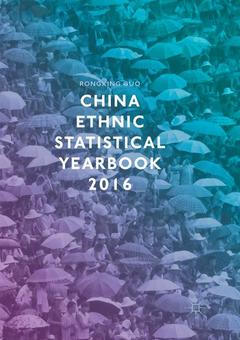Description
China Ethnic Statistical Yearbook 2016, Softcover reprint of the original 1st ed. 2017
Author: Guo Rongxing
Language: English
Subjects for China Ethnic Statistical Yearbook 2016:
Approximative price 137.14 €
In Print (Delivery period: 15 days).
Add to cartPublication date: 07-2018
Support: Print on demand
Approximative price 137.14 €
In Print (Delivery period: 15 days).
Add to cartPublication date: 05-2017
Support: Print on demand
Description
/li>Contents
/li>Biography
/li>Comment
/li>
This book, comprised of entirely original research, collects data on the socioeconomic situation of China?s 56 ethnic groups. Although the majority of China?s population is of the Han nationality (which accounts for more than 90% of China?s population), the non-Han ethnic groups have a population of more than 100 million. China has officially identified, except for other unknown ethnic groups and foreigners with Chinese citizenship, 55 ethnic minorities. In addition, ethnic minorities vary greatly in size. With a population of more than 15 million, the Zhuang are the largest ethnic minority, and the Lhoba, with a population of only about three thousand, the smallest.
China?s ethnic diversity has resulted in a special socioeconomic landscape for China itself. However, till presently, a complete socioeconomic picture of China?s ethnic groups ? especially of its smallest ethnic minorities ? still remained unclear. How different have China?s ethnic groups been in every sphere of daily life and economic development during China?s fast transition period? In order to answer these questions, we have created a detailed and comparable set of data for each of China?s ethnic groups.
This book presents, in an easy-to-use format, a broad collection of social and economic indicators on China?s 56 ethnic groups. This useful resource profiles the general social and economic situations for each of these ethnic groups. These indicators are compiled and estimated based on the regional and local data gathered from a variety of sources up to 2012.
Rongxing Guo is a professor at the Regional Science Association of China at Peking University, China. He has published widely on topics such as global and regional issues (with an emphasis on cross-border issues) and Chinese economics. He has 30 years of experience teaching and researching in China, as well as in Australia, Japan, South Korea, Italy, Germany and the USA. He has led research projects for the OECD and the World Bank, and undertaken consultation for the Chinese government.
Provides explanatory notes on China’s main socioeconomic indicators
Provides a broad collection of annual data on China’s 56 ethnic groups
Profiles the demographic, cultural, economic, and business climates for each of these ethnic minorities
Of great value to researchers, businesses, government agencies, and news media.




